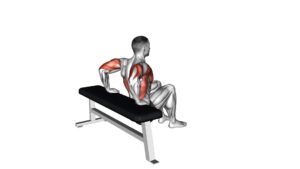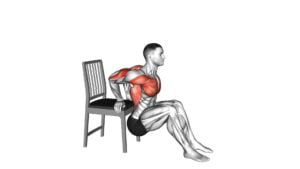Bench Dip (Knees Bent) (Female) – Video Exercise Guide & Tips

Are you looking for a challenging exercise to target your triceps? Look no further than the bench dip (knees bent) exercise!
Watch This Exercise Video
In this video exercise guide, we'll show you the proper form and technique to perform this exercise effectively.
You'll also find tips to increase the intensity and challenge yourself, as well as modifications for different fitness levels.
Avoid common mistakes and maximize your results with our helpful tips and tricks.
Let's get started!
Key Takeaways
- The bench dip (knees bent) exercise targets triceps, shoulders, chest, and core muscles.
- There are variations and modifications available for different fitness levels and goals.
- Proper form and technique are essential for maximizing results and preventing injury.
- Tips to increase intensity and challenge yourself include elevating feet, adding weight, using a stability ball, performing eccentric reps, and combining with other exercises.
Benefits of the Bench Dip (Knees Bent) Exercise
Discover the numerous benefits you can achieve from incorporating the bench dip (knees bent) exercise into your workout routine. Not only does this exercise target your triceps, it also engages your shoulders, chest, and core muscles. The bench dip (knees bent) exercise is a versatile movement that can be modified to meet your fitness level and goals.
One benefit of the bench dip (knees bent) exercise is the ability to perform variations. By adjusting the position of your feet or hands, you can target different areas of your upper body. For instance, placing your feet on an elevated surface will increase the intensity, focusing more on your triceps. On the other hand, placing your hands closer together will engage your chest muscles.
Incorporating the bench dip (knees bent) exercise into a full body workout routine can provide added benefits. By including this exercise, you can work multiple muscle groups simultaneously, saving time and maximizing efficiency. Additionally, the bench dip (knees bent) exercise can help improve your overall upper body strength and stability.
To reap the full benefits of the bench dip (knees bent) exercise, it's important to maintain proper form and technique. Keep your back straight, engage your core, and lower your body until your upper arms are parallel to the ground. Remember to breathe throughout the movement and avoid locking your elbows.
Incorporating the bench dip (knees bent) exercise into your workout routine can help you achieve a stronger and more toned upper body. By performing variations and including it in a full body workout, you can experience the maximum benefits of this exercise.
Proper Form and Technique for the Bench Dip (Knees Bent)
To ensure optimal results and minimize the risk of injury, it's crucial to master the proper form and technique for the bench dip (knees bent) exercise. When performing this exercise, there are a few common mistakes to avoid.
One mistake is allowing your elbows to flare out to the sides, which puts unnecessary strain on your shoulders. Instead, make sure to keep your elbows close to your body throughout the movement.
Another common mistake isn't engaging your core muscles. To avoid this, focus on keeping your abdominals tight and your back straight throughout the exercise.
In addition to proper form, there are also variations of the bench dip (knees bent) exercise that you can incorporate into your routine.
One variation is the weighted bench dip, where you add extra resistance by placing a weight plate on your lap. This can increase the challenge and help you build more strength in your triceps.
Another variation is the single-leg bench dip, where you extend one leg straight out in front of you while performing the exercise. This variation adds an extra level of difficulty and engages your stabilizing muscles.
Remember, mastering the proper form and technique for the bench dip (knees bent) exercise is essential for maximizing your results and minimizing the risk of injury.
Tips to Increase Intensity and Challenge Yourself
To continue increasing the intensity and challenging yourself during the bench dip (knees bent) exercise, focus on incorporating advanced variations and increasing the resistance. Here are some tips to help you modify the bench dip exercise and incorporate it into a full-body workout routine:
- Elevate your feet: Place your feet on a higher surface, such as a bench or stability ball, to increase the difficulty and engage your triceps even more.
- Add weight: Hold a dumbbell or a weight plate on your lap while performing the bench dip to add resistance and further challenge your muscles.
- Use a stability ball: Instead of a bench, perform the dip with your hands on a stability ball. This will engage your core muscles and increase the instability, making the exercise more challenging.
- Perform eccentric reps: Slow down the lowering phase of the dip, taking at least 3-4 seconds to lower yourself down. This will increase time under tension and stimulate muscle growth.
- Combine with other exercises: Incorporate the bench dip into a full-body workout routine by pairing it with exercises like push-ups, tricep pushdowns, or shoulder presses. This will help you work multiple muscle groups and maximize your workout.
Modifications and Progressions for Different Fitness Levels
To continue challenging yourself and progressing in your fitness journey, consider modifying and progressing the bench dip exercise based on your current fitness level. There are several modification options for bench dips that can be tailored to your needs.
If you're a beginner or have limited upper body strength, you can start by using a bench or chair that's at a higher height, allowing for less resistance. As you become more comfortable and stronger, you can gradually lower the height of the bench or chair to increase the difficulty level.
Additionally, you can also modify the exercise by bending your knees instead of keeping your legs straight, which can help to reduce strain on your shoulders and focus more on your triceps.
For those looking for advanced variations of the bench dip exercise, you can try adding weights on your lap or using a stability ball to challenge your stability and engage more muscle groups. Another option is to perform the exercise using parallel bars or dip bars, which require more upper body strength and stability.
By modifying and progressing the bench dip exercise, you can continue to challenge yourself and improve your fitness level.
Now, let's transition into the next section where we'll discuss common mistakes to avoid while performing bench dips (knees bent).
Common Mistakes to Avoid While Performing Bench Dips (Knees Bent)
Avoiding common mistakes is crucial for proper execution of bench dips (knees bent) and optimal results. Here are some common mistakes to avoid while performing bench dips with knees bent:
- Rounding your shoulders: Keep your shoulders back and down throughout the entire movement. This helps to engage the correct muscles and prevents unnecessary strain on your shoulders.
- Allowing your elbows to flare out: Keep your elbows close to your sides as you lower yourself down. This targets your triceps more effectively and reduces the risk of shoulder discomfort.
- Not engaging your core: Your core muscles play a crucial role in stabilizing your body during bench dips. Remember to engage your core by pulling your belly button towards your spine throughout the exercise.
- Rushing the movement: Slow and controlled movements are key to maximizing the benefits of bench dips. Avoid rushing through the exercise and focus on maintaining proper form.
- Neglecting proper breathing: Breathe in as you lower yourself down and exhale as you push yourself back up. Proper breathing helps to maintain stability and control during the exercise.
Frequently Asked Questions
How Many Calories Can You Burn by Doing Bench Dips (Knees Bent)?
When you do bench dips with your knees bent, you can burn calories while targeting your triceps and shoulders. The exact number of calories burned will depend on factors like your weight, intensity, and duration of the exercise.
To maximize calorie burn, maintain proper form by keeping your elbows close to your body and lowering yourself until your upper arms are parallel to the ground.
Remember to consult with a fitness professional for personalized advice.
Can Bench Dips (Knees Bent) Help Improve Upper Body Strength?
Bench dips (knees bent) are a great exercise to improve your upper body strength. By incorporating them into your full body workout routine, you can target your triceps, shoulders, and chest muscles.
To perform them correctly, keep your back close to the bench, bend your knees, and lower your body down while keeping your elbows at a 90-degree angle.
Remember to engage your core and avoid any jerky movements. With consistent practice, you'll see improvements in your upper body strength.
Are There Any Variations of Bench Dips (Knees Bent) That Target Specific Muscle Groups?
There are several variations of bench dips (knees bent) that target specific muscle groups. These variations include using different hand positions, elevating the feet, or adding weights.
Each variation focuses on different areas like triceps, chest, or shoulders.
Can Bench Dips (Knees Bent) Help With Improving Posture?
Bench dips (knees bent) can indeed help improve your posture. By strengthening your triceps, shoulders, and core muscles, bench dips can help you maintain a more upright position and prevent slouching.
Additionally, bench dips promote flexibility in your shoulders and chest, which can further enhance your posture.
The benefits of bench dips extend beyond posture improvement, as they also help build upper body strength and stability.
Are There Any Specific Safety Precautions to Keep in Mind While Performing Bench Dips (Knees Bent)?
When performing bench dips (knees bent), it's important to keep a few safety precautions in mind.
First, make sure you have proper form by keeping your back straight and core engaged. Avoid locking your elbows and instead, maintain a slight bend.
Additionally, if you experience any pain or discomfort, stop the exercise and consult a professional.
Conclusion
In conclusion, the bench dip (knees bent) exercise is a great way to strengthen and tone your triceps. By following proper form and technique, you can maximize the benefits of this exercise.
To increase intensity, try adding weights or performing more repetitions. Modifications and progressions are available for all fitness levels, allowing everyone to challenge themselves.
Remember to avoid common mistakes to ensure safe and effective performance of bench dips.

Author
Years ago, the spark of my life’s passion ignited in my mind the moment I stepped into the local gym for the first time. The inaugural bead of perspiration, the initial endeavor, the very first surge of endorphins, and a sense of pride that washed over me post-workout marked the beginning of my deep-seated interest in strength sports, fitness, and sports nutrition. This very curiosity blossomed rapidly into a profound fascination, propelling me to earn a Master’s degree in Physical Education from the Academy of Physical Education in Krakow, followed by a Sports Manager diploma from the Jagiellonian University. My journey of growth led me to gain more specialized qualifications, such as being a certified personal trainer with a focus on sports dietetics, a lifeguard, and an instructor for wellness and corrective gymnastics. Theoretical knowledge paired seamlessly with practical experience, reinforcing my belief that the transformation of individuals under my guidance was also a reflection of my personal growth. This belief holds true even today. Each day, I strive to push the boundaries and explore new realms. These realms gently elevate me to greater heights. The unique combination of passion for my field and the continuous quest for growth fuels my drive to break new ground.







